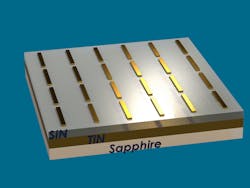To enable construction of high-temperature optical metamaterials, researchers at Purdue University (West Lafayette, IN) are working to replace silver and gold with high-temperature-resisting materials such as titanium nitride (TiN) and zirconium nitride (ZrN). Potential uses include thermophotovoltaics and heat-assisted magnetic recording (HAMR) data-storage drives.1
"These materials remain stable at the high operational temperatures required for high efficiency and performance," said Urcan Guler, one of the researchers.
A new class of plasmonic technologies could use high temperatures to achieve superior efficiency; for example, in solar thermophotovoltaics, an ultrathin layer of plasmonic metamaterials could dramatically improve solar cell efficiency by converting visible light to near-IR, potentially boosting efficiency from 15% to as high as 85%.
One obstacle, however, is that the operational temperature required for high-efficiency devices is estimated to be around 1500 degrees C. TiN and ZrN have high melting points and chemical stability at temperatures above 2000 degrees C.
Previous research explored the use of refractory metals such as tungsten or tantalum, which are not good plasmonic materials. Using these metals requires a layer 20 times thicker than is possible with the plasmonic metamaterials, making it far more vulnerable to mechanical stresses caused by the constant expansion-contraction cycle of solar thermophotovoltaic devices.
Two of the scientists have formed a startup company, Nano-Meta Technologies Inc., based at the Purdue Research Park. Nano-Meta Technologies is focusing initially on three applications: solar thermophotovoltaics, HAMR, and a new clinical therapeutic approach.
In the clinical therapeutic concept, TiN nanoparticles might be injected into the bloodstream so that they accumulate in tumors. Clinicians might shine a certain wavelength of light on these nanoparticles from outside the body, causing the particles to heat up and killing the cancer cells.
For more info, see http://www.nanometatech.com/.
REFERENCE:
1. Urcan Gule et al., Science (2014); doi: 10.1126/science.1252722

John Wallace | Senior Technical Editor (1998-2022)
John Wallace was with Laser Focus World for nearly 25 years, retiring in late June 2022. He obtained a bachelor's degree in mechanical engineering and physics at Rutgers University and a master's in optical engineering at the University of Rochester. Before becoming an editor, John worked as an engineer at RCA, Exxon, Eastman Kodak, and GCA Corporation.
